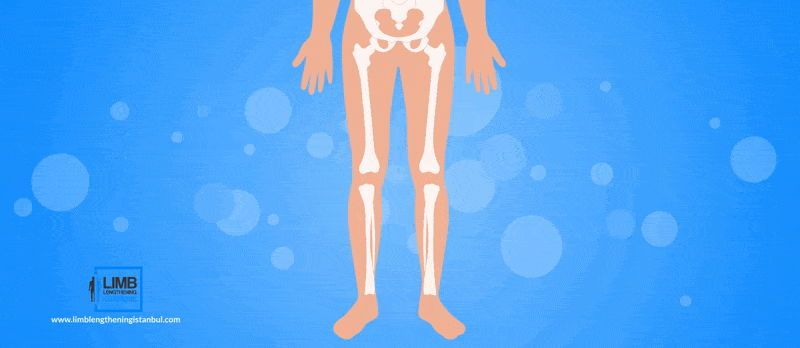The LON method is an operation method that combines both an external fixator and an intramedullary nail. In the LON method, an intramedullary nail, which is made of titanium, will be placed in your bone, and the lower end of this nail will be left free for lengthening. After intramedullary nail placement, an external fixator will be located outside of the leg, and lengthening will be controlled on this external fixator.
Every day, the extending section of the fixator is turned by hand using a specialized tool. The external fixator is surgically removed from the extremity at the end of the extension phase. Classical limb lengthening with an external fixator takes a long period to regenerate a fully consolidated femur or tibia bone.
Patients are generally dissatisfied since they have to carry an external fixator for an extended period of time. One benefit of LON is that, unlike consolidation, patients carry the external fixator only during lengthening progress. LON reduces the fixator time by half or less than half as compared to traditional lengthening using an external fixator alone. The other benefit of the Lon method is being weight-bearable. The Lon method can stay durable until 100 kg.

Benefits of LON Method
- Enables patients to significantly enhance their tibial and femur height by up to 6-7 cm and 8-9 cm, respectively.
- The patient carries the external fixator for a brief period of time, usually 70–90 days.
- Speeds up recovery by enabling patients to walk throughout the lengthening period.
- After the operation, patients can resume their regular walking routine in four to five months.
- Lessens surgical scarring compared to completely external techniques like Ilizarov, regarded as reasonably priced and secure.
The drawbacks of the LON Method
- Needs to be dressed often at pin locations in order to reduce the chance of infection.
- More damaging than internal techniques
- External fixators could be uncomfortable.
- With our cutting-edge leg-lengthening operation, professional postoperative care, and rehabilitation, you may enhance your quality of life.
Components of the LON Method
External fixator for femur
It is a robust metal stabilizing frame that maintains the bone's stability during the lengthening process. The illustration below illustrates how metal bars are pinned to the bones. Depending on the desired height, the gadget is retained for two to three months.
Assembly clamps, rails, and distraction-compression units are examples of external fixators. In order for them to glide on the rail, clamps are inserted. With the use of distraction-compression units, they can be linked together. Half pins are used to attach the rail fixator to the extremity. The external fixator is constructed using metal alloy that can support a lot of weight. For femoral (upper leg) cosmetic lengthening procedures using the LON technique, our surgeon prefers the Monorail external fixator. Daily Using specialized equipment, the distraction units are manually turned to achieve lengthening. The patient can walk with full weight bearing because to the monorail's great weight-bearing capacity.

Circular frame (ilizarov) for tibia bones
Utilized in orthopedic operations for bone regeneration and limb lengthening, the Ilizarov apparatus is a specialized external device. The titanium or stainless steel rings surround the limb and serve as a foundation for the device. After that, these rings are connected to heavy-gauge stainless steel wires and pins that are put into the bone. Threaded rods and nuts are used to attach and reposition the rings. Because its circular shape prevents tibia lengthening deformity, our surgeons use this Ilizarov device for tibia bones. The patient can walk fully weight-bearing because of the circular frame's strong weight-bearing capacity. The patient needs to turn the fixator's rods manually to produce daily lengthening.

Intramedullary Nail
An intramedullary nail or rod, composed of titanium alloy, is used for internal fixing. By examining the X-ray pictures, the physician determines the nail's size. 8 mm, 10 mm, 10 mm, 11 mm, or 12 mm) It is inserted surgically into the bone cavity during the procedure. The nail is biocompatible, meaning that it has no substances that could harm the body.

An Outside Look at the LON Method
Use our expert techniques to get the most comfortable limb lengthening. The monorail fixator on the outer thigh of Limb Lengthening Istanbul's femur LON technique provides support via two upper and two lower pins. Our circular frame fixator has been creatively adapted for improved comfort and weight reduction in the tibia LON technique. It connects effortlessly with one pin and two wires proximally and one pin and two wires distally. You may count on us for a safe and comfortable limb-lengthening surgery because Limb Lengthening Istanbul is at the forefront of patient-centered solutions.


LON Method Operation
The surgeon and his team design the operation based on the physical assessment and the comprehensive X-ray taken prior to the procedure. With more than 25 years of expertise in limb lengthening and deformity repair, our surgeon and his colleagues professionally execute limb lengthening operations. General anesthesia is used during the LON method operation. The crew and anesthesiologist are prepared for the procedure. Typically, the operation takes three to four hours. phases of operation;
- General anesthesia,
- Intramedullary canal drilling,
- Osteotomy,
- Solid intramedullary nail insertion,
- Locking the proximal portion of the intramedullary nail to the bone,
- And attaching the external fixator to the bone using wires and pins are the procedures involved
Every incision is made as small as possible—less than 2 cm. Every step of the procedure is guaranteed to go well with immediate x-rays. Specialists in intramedullary nails and external fixators are present during the procedure and collaborate with our surgeon.
LON Method—Fixator Removal Operation
The fixator removal operation is carried out after the patient achieves the desired result. Before the removal procedure, an x-ray of the complete leg is taken to measure the length of the bones, the length of the osteotomy, the length of the entire leg, and the quality of the callus (new bone tissue). The patient is given further time to equalize their leg length if there is any disparity. The operational date is confirmed if the callus tissue is of adequate quality. The procedure is carried out while under general anesthesia. About two hours are needed for the operation.
- General anesthesia
- Operating room x-ray to assess bone length and alignment from all directions.
- Fastening the intramedullary nail's distal end to the bone External fixator pins and wires are removed and separated from the extremity.
- If required, muscles are lengthened.
- All wounds are sutured and dressed.
After the fixator removal operation, patients often stay in the hospital for one day. Our surgeon and his staff are in charge of gait control and physical examinations at the hospital. Following the procedure, the patient is discharged from the hospital after a final x-ray examination.
LON Method's Consolidation Period
The freshly generated callus (new bone tissue) hardens and consolidates during the consolidation phase. During this period, patients who undergo lengthening using the LON approach are at an advantage. Patients can move around with full weight bearing because IM nails are so durable, but we advise using crutches or a walker in the initial days following the fixator removal operation until the patient has enough range of motion, muscle strength, and balance again. Our LON patients have a very high recovery rate as long as the safe extension limits are maintained. After the fixator is removed, patients can usually walk unassisted for one to two months, depending on the rate of callus formation, the lengthening, and the soft tissues' ability to recover. Patients can resume their regular daily physical activities as soon as unassisted walking starts since other activities are promptly restored.


